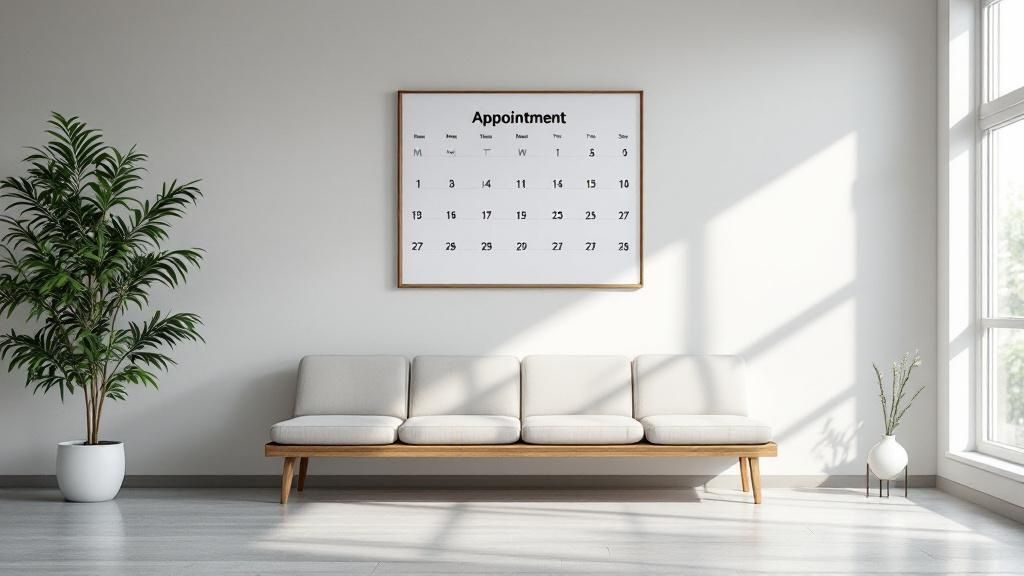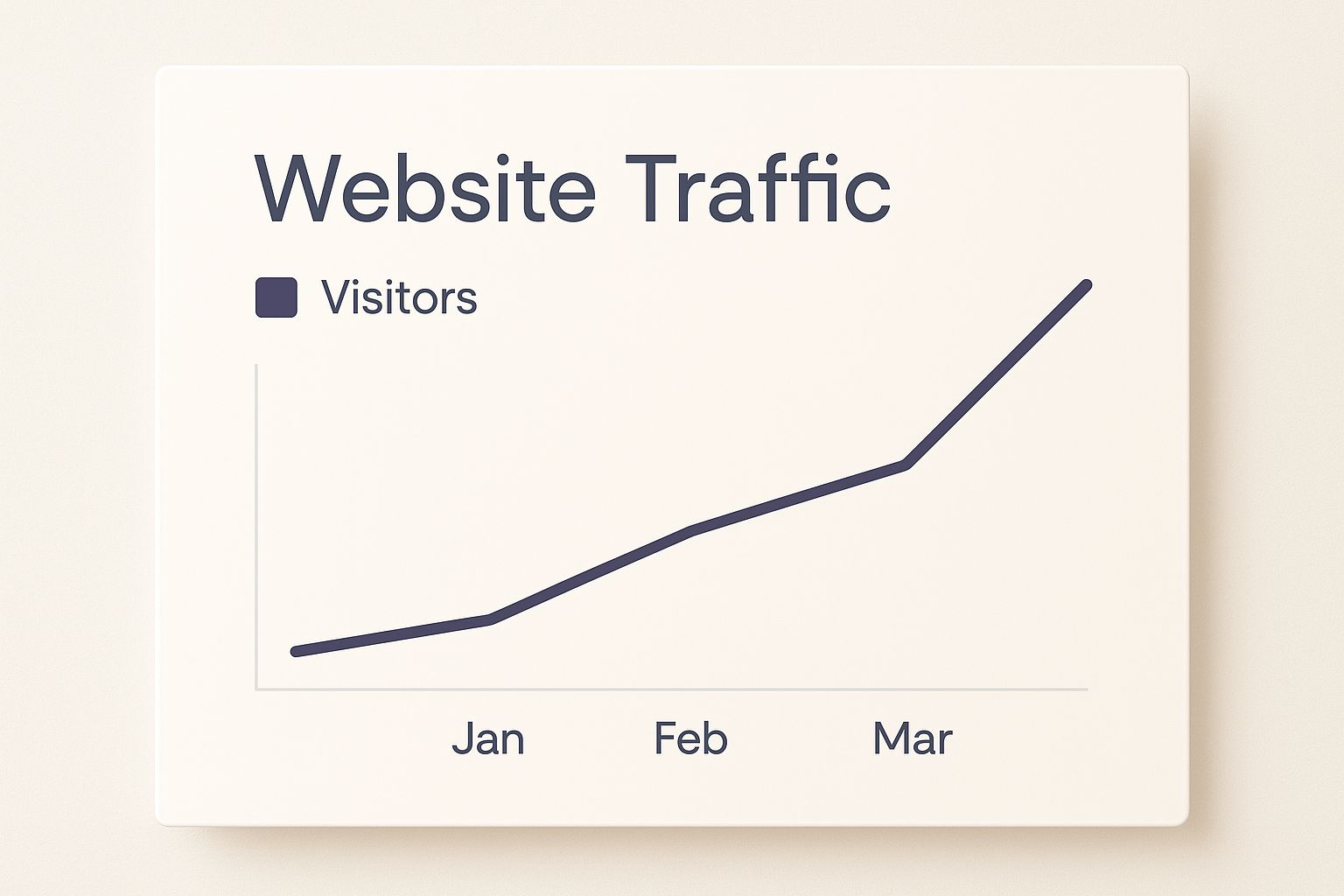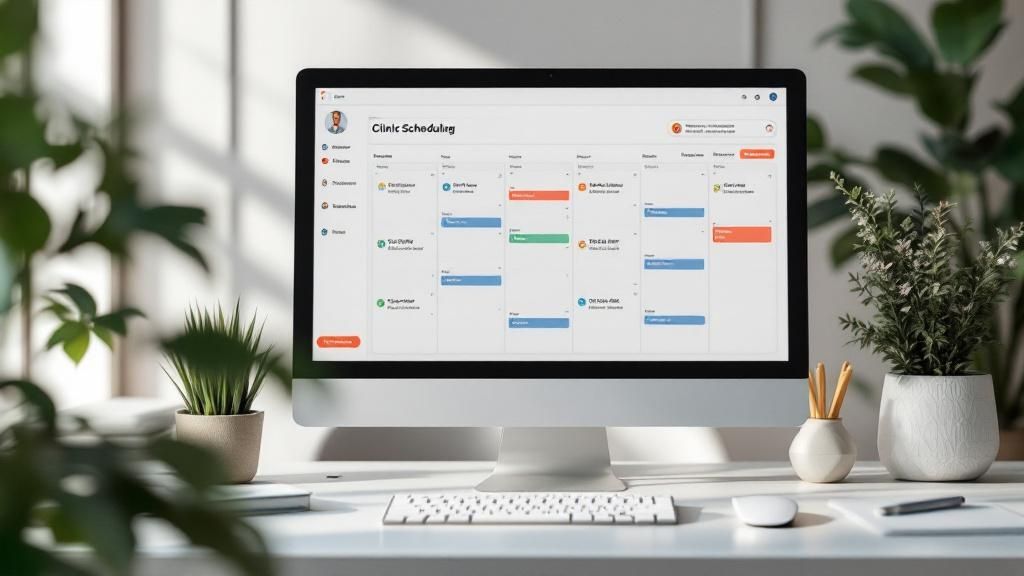Why Patients Really Skip Appointments (It's Not What You Think)
Let's be honest, the reasons patients say they miss appointments and the real reasons are often miles apart. Sure, transportation and scheduling conflicts play a role, but dig a little deeper. How many patients openly admit to being anxious about their appointment or embarrassed about finances? Not many.

This screenshot highlights some common culprits behind no-shows, like forgetfulness and miscommunication. Interestingly, it points to digital tools as a big part of the solution. The key takeaway? Proactive communication – reminders, easy rescheduling – can drastically reduce no-shows.
Remember, different patients have different triggers. A busy parent juggling childcare might miss appointments for reasons completely different from a senior citizen struggling with transport. Understanding these nuances is key. Research shows 52% of consumers reported missing a healthcare appointment in the past year. That’s huge. Simple things – flexible appointment times, clear pre-appointment instructions – can make a real difference. And digital reminders? They can slash no-show rates by up to 70%. Want to dive deeper into how effective digital reminders can be? Discover more insights.
The Financial Impact of No-Shows
Let's talk money. Every empty appointment slot is lost revenue and wasted resources. The global average no-show rate is 23.5%. In outpatient settings, it swings between 23% and 33%, depending on the specifics. Generic, one-size-fits-all solutions often fail because they don't address the root causes. What works for one practice might not work for another. Same goes for patients. It’s about understanding the why behind the missed appointment and tailoring your approach accordingly. This deeper understanding of patient behavior is the real key to a full schedule and a healthier bottom line.
Let's take a look at no-show rates across different specialties to illustrate this point.
To illustrate this, let's take a look at the breakdown of no-show rates across different specialties. Understanding these nuances is crucial for tailoring effective strategies.
Common No-Show Rates by Medical Specialty
| Medical Specialty | Average No-Show Rate | Primary Contributing Factors |
|---|---|---|
| Dermatology | 15-20% | Forgetfulness, cosmetic procedure anxiety |
| Oncology | 10-15% | Treatment side effects, emotional distress |
| Primary Care | 20-25% | Busy schedules, perceived lower urgency |
| Cardiology | 15-20% | Procedure preparation complexity, anxiety |
| Mental Health | 25-30% | Stigma, difficulty discussing mental health |
This table represents average ranges and can vary based on location, practice type, and patient demographics.
As you can see, the factors influencing no-shows differ significantly between specialties. This highlights the need for targeted interventions. For example, addressing anxiety in cosmetic dermatology might involve pre-appointment reassurance and clear communication. While in mental health, strategies might focus on reducing stigma and offering flexible appointment options. Understanding these nuances is the foundation of a successful no-show reduction strategy.
Building Reminder Systems That Patients Actually Read
Let's be honest, generic appointment reminders often end up ignored. They feel like spam, and nobody wants more of that. Successful practices get this. They know that effective reminders are more like a friendly conversation spread across several touchpoints. Timing and the words you use? Absolutely key.

This image perfectly captures the essence of a good reminder. Clean, simple, and straight to the point on a smartphone. It's a visual reminder (pun intended!) of how a well-crafted digital message can cut through the noise.
Think about it. A bland "Confirm your appointment tomorrow at 2 PM" is easy to dismiss. But something like, "Hi [Patient Name], Just a friendly reminder about your appointment with Dr. [Doctor's Name] tomorrow at 2 PM for [Reason for Visit]. Reply YES to confirm or call us to reschedule." feels much more personal and actionable. It's much more likely to get a response.
Choosing the Right Channels and Frequency
One size doesn't fit all when it comes to communication. Younger patients might prefer texts, while older patients might appreciate a phone call. Don't guess! Ask your patients what works best for them during intake. Write it down. This personalized approach makes a huge difference in how patients perceive your reminders. It keeps them engaged and prevents them from feeling bombarded. Speaking of which, you might find Simbie AI's resources on patient appointment reminders helpful.
Frequency matters too. Daily reminders can be overkill. A well-timed sequence – say, a week before, two days before, and then the day of the appointment – is usually much more effective.
Automating With a Human Touch

This screenshot of the Simbie AI platform shows how technology can streamline this whole process. Automating reminders frees up your staff to focus on other important tasks, all while maintaining that personal touch. Tools like Simbie AI integrate with your current systems, allowing you to send targeted, personalized reminders based on individual patient preferences. This is a win-win – consistent communication without overwhelming your team.
Let's talk about reminder effectiveness. I've found that different methods yield different results depending on who you're trying to reach. The table below shows some of the key differences:
| Reminder System Effectiveness Comparison | Performance metrics for different reminder methods and timing strategies |
|---|---|
| Reminder Method | Effectiveness Rate |
| — | — |
| Text Message | 70-80% |
| Phone Call | 60-70% |
| 40-50% | |
| Automated Voicemail | 30-40% |
As you can see, text messages tend to have the highest effectiveness rate, especially for younger patients and busy professionals. However, phone calls can be more impactful for older patients or those who may not regularly check their texts or emails. Each method has its strengths and weaknesses, so it's crucial to tailor your strategy accordingly.
Handling Non-Responses
So, what happens when a patient doesn't respond? Don't jump straight to no-show fees. Try a friendly follow-up call or message expressing genuine concern. Life happens, and sometimes appointments slip through the cracks. A little empathy can go a long way in building patient loyalty. Remember, the goal is to minimize no-shows, not to alienate patients. A balanced, compassionate approach fosters a positive patient-practice relationship, leading to a more efficient and successful practice overall.
The Truth About No-Show Fees (And When They Backfire)
Let's be honest, no-show fees are a tricky subject. While charging for missed appointments seems like a straightforward solution to recoup lost revenue, it can sometimes create more problems than it solves. Getting this wrong can actually drive patients away and breed resentment. It’s a tightrope walk, really.

This screenshot is from the Medical Group Management Association (MGMA) website—a fantastic resource if you're in healthcare. They offer tons of practical advice on everything from streamlining your practice to boosting your financial performance, including smart strategies for dealing with no-shows.
Successfully navigating no-show fees requires a deep understanding of the potential pros and cons. For example, some practices have seen fantastic results by combining fees with flexible waiver policies for true emergencies. This shows compassion, and patients really respond to that. But I've also seen the opposite, where rigid policies alienated patients, especially those struggling financially.
No-show fees are definitely a growing trend. As of January 2025, 42% of medical group leaders in the US reported using them. Practices implementing fees saw a bump in attendance – 25% reported better rates in 2024 compared to 16% without. This data highlights the potential financial upside, especially considering the estimated $150 billion annual loss from no-shows nationwide. Intrigued? Discover more insights on this rising trend.
Alternatives to Fees: When Consequences Work Better
Sometimes, the best solution isn't about money. Think about alternative consequences. For instance, rescheduling chronic no-show patients for same-day appointments only can be surprisingly effective. It introduces a sense of urgency without the financial penalty.
Another idea? A "three strikes" policy. After three no-shows, the patient might be asked to find a new provider. This sets clear boundaries while trying to preserve the doctor-patient relationship for as long as possible.
Communicating Your Policy Effectively
Regardless of your approach, communication is key. Don't bury your policy in the fine print. Explain it clearly during the patient intake process and reiterate it in appointment reminders.
Use supportive, not punitive language. Instead of "You will be charged," try phrasing it as, "To ensure we can continue providing quality care for all our patients, we have a no-show policy…" This subtle shift can dramatically change how patients perceive the policy. Frame it as a shared responsibility, not a punishment. This fosters a more positive experience and improves the chances of patients showing up.
Making Scheduling Work For Real Life (Not Just Your Preferences)
Rigid scheduling? Let's be honest, it just doesn't work in the real world. We've all been there – unexpected kid emergencies, last-minute work changes, life just throws curveballs. Your scheduling system needs to roll with the punches, not make things harder. Smart practices are getting this and changing how they approach appointments.
Same-Day Scheduling and Smart Waitlists
Think same-day scheduling for patients with a history of no-shows sounds crazy? It can actually be a game-changer. Offering that immediate availability can surprisingly motivate those patients to show up. Pair this with a dynamic waitlist and suddenly cancellations aren't lost revenue, they're opportunities. Someone cancels? Boom, you've got a list of people ready to fill that slot. It keeps things moving smoothly and efficiently.
Offering a Variety of Appointment Types
One size doesn't fit all, right? The same goes for appointments. Sometimes a patient just needs a quick check-in or a telehealth consultation via platforms like Zoom, not a full office visit. Offering shorter appointments, virtual options, and different formats acknowledges that not every health issue needs the same level of attention. Think about it: someone might prefer a virtual visit because of distance or a busy schedule, while others value that face-to-face time. Giving patients options removes barriers and can significantly boost attendance.
Strategic Overbooking (Yes, Really)
Overbooking might seem risky, but if you do it strategically, it can be a powerful tool. The key is to analyze your no-show trends first. Understand your patterns, then use that data to overbook just the right amount. This lets you optimize your schedule without making patients wait forever. If you're looking to get even smarter with this, check out how AI can help: Simbie AI's solutions for scheduling optimization using AI voice agents.
Tools like Calendly are a great example of how modern scheduling software makes life easier. You can customize appointment times, automate reminders, and generally streamline the whole process. It empowers patients to manage their own schedules and frees up your staff to focus on other things.
Flexible scheduling is showing real promise in reducing no-shows. Patient no-shows can range from a low of 5.5% all the way up to 50% in the U.S., with a global average of 23.5%. That's a huge range! Practices that offer flexible rescheduling and same-day appointments are seeing real improvements. Want to dive deeper into reducing no-shows? Learn more about reducing patient no-shows here. Adaptable scheduling and telehealth options can address common barriers like transportation or work conflicts, which are major reasons for missed appointments.
By focusing on flexibility and what patients actually need, you can create a scheduling system that benefits everyone. The results? Higher attendance rates, happier patients, and a smoother, more successful practice.
Getting Ahead of No-Shows With Smart Technology
Let's talk about no-shows. They're a pain, right? But instead of constantly reacting to them, what if you could predict and prevent them? It’s totally possible. Forward-thinking practices are already using patient data, scheduling habits, and even info about local events to identify appointments that are at risk before they turn into no-shows.

I recently saw this screenshot from Simbie AI's website, and it perfectly illustrates how a clean, intuitive interface can make all the difference. They focus on clear communication and streamlined workflows, highlighting how AI can simplify complex tasks. Simbie AI, and tools like it, analyze patient behavior and communication history to flag potential no-shows, giving you the time to step in.
Spotting the Red Flags in Your Current System
You absolutely don’t need fancy tech to start predicting no-shows. There are clues hiding right in your current system. For example, think about your appointment times. Do Monday mornings or Friday afternoons consistently have higher no-show rates? That data is gold, use it! It can inform your future scheduling.
Another thing to consider: patient portal activity. Patients actively using the portal are way more likely to show up for their appointments. If you see inactivity, that's a red flag. It’s your cue to reach out, check in, and re-engage those patients.
Leveraging Automation for Proactive Prevention
Automated waitlist management can be a game changer. A patient cancels? Boom, the system instantly fills the slot with someone from the waitlist. No more empty appointment slots, just pure efficiency.
And then there are smart scheduling algorithms, like the ones Simbie AI offers. They consider everything: patient preferences, appointment types, and historical data. This minimizes scheduling conflicts before they even happen. It's all about working smarter, not harder. This kind of proactive approach makes life easier for your staff and creates a smoother scheduling process for everyone.
The Power of Feedback Loops
Closing the loop with patient feedback is essential. After each appointment, gather data: why did they show up, cancel, or not show at all? Were there unexpected issues? Did your reminders work? These insights will refine your system’s prediction accuracy over time.
It's a continuous improvement process. You're constantly learning and adapting to patient needs. This leads to even lower no-show rates down the line. By switching from reactive to proactive, you gain control over your schedule and, ultimately, provide better care.
Creating A Practice Patients Want To Show Up For
Let's be honest: the best way to reduce patient no-shows isn't some complicated system or a bunch of penalties. It's about creating a practice that patients actually look forward to visiting. This means going beyond simple appointment reminders and building a welcoming environment where patients feel valued and respected.
Think of it like this: you're more likely to show up at a restaurant where you know you'll get great service and a delicious meal, right? Your medical practice should strive for the same kind of positive experience.
This screenshot from Wikipedia's page on Patient Experience perfectly illustrates this point. It highlights all the different touchpoints – from the initial phone call to the follow-up – that shape a patient's overall perception. It’s not just about clinical outcomes; the emotional and even physical environment plays a huge role. The takeaway? Every interaction, big or small, counts.
Minimizing Wait Times Without Expanding Staff
I know, I know, long wait times are a huge pain point. Nobody wants to spend their afternoon twiddling their thumbs in a waiting room. But hiring additional staff isn't always an option. So what can you do? Focus on optimizing your existing workflows.
One simple but effective strategy? Accurately estimate appointment times. A routine check-up shouldn’t be blocked off for the same amount of time as a more complex procedure. This seemingly small adjustment can prevent backlogs and keep your schedule running smoothly. Staggering appointments can also help avoid those dreaded rush hour periods.
Communication That Builds Loyalty
The way your team interacts with patients – from the first hello to the final goodbye – has a direct impact on whether they'll come back. Train your staff to communicate with empathy and respect. A little consideration goes a long way. Something as simple as saying, "We understand your time is valuable," can make a difference.
Personalizing each interaction is also key. Using the patient's name and acknowledging their individual concerns makes them feel seen and heard. This helps build rapport and strengthens the patient-practice relationship, making them much less likely to skip appointments.
Training Your Team for Attendance Success
Your front desk staff are the face of your practice. They set the tone for the entire visit, so invest in training that prioritizes patient-centered communication.
Role-playing challenging scenarios, like rescheduling appointments with chronic no-shows, can give your team the confidence and skills to handle these situations effectively. Providing scripts that balance firmness with empathy is also helpful. For example, instead of saying, "You missed your appointment," try, "We noticed you weren't able to make your last appointment. Is everything alright?" This subtle shift can make a world of difference.
Turning Difficult Conversations into Opportunities
Chronic no-shows can be frustrating, but they're also a chance to understand what's really going on. Instead of punishing patients, try open communication. Develop scripts that focus on understanding their perspective.
Maybe they’re facing transportation challenges or struggling with scheduling conflicts. Perhaps they're experiencing anxiety about their treatment. By actively listening and offering support, you can often turn a chronic no-show into a loyal patient. This approach reinforces that your practice is a safe and supportive environment, encouraging patients to actively participate in their care.
Tracking What Matters and Getting Better Over Time
Most practices track basic no-show rates. Okay, that’s a start, but it's like checking your blind spot after you've already merged lanes—helpful, but a little late. To really reduce no-shows, you need to understand what’s causing them in the first place. So, which metrics give you those crucial early warning signs?
Beyond Basic No-Show Rates: Digging Deeper
Forget simple percentages. Are you tracking no-shows by appointment type, day of the week, or even time of day? For instance, in my experience, new patient appointments tend to have a higher no-show rate than follow-ups. And Monday mornings? Always a struggle. This granular data tells a story. It helps you see those hidden patterns that can totally change your scheduling strategy and how you reach out to patients beforehand.
Identifying Early Warning Indicators
Some metrics can actually predict future no-shows. I've found a strong link between patient portal activity and attendance. Patients who are actively using the portal are much more likely to show up. On the other hand, inactivity? Big red flag. That’s your cue to reach out, check in, and get those patients re-engaged. Learn more about streamlining your processes in our guide on healthcare process improvement.
Another indicator? How far in advance patients book. Appointments booked months out? Way more likely to be forgotten. Tracking booking lead times helps you pinpoint those at-risk appointments and tailor your reminders accordingly.
Simple Tracking Methods for Real Results
You don't need fancy software to get this going. A simple spreadsheet can be surprisingly powerful. Track appointment details, patient demographics, reminder methods, and of course, whether they showed. Over time, this data will reveal gold. For example, I found that text reminders worked better than phone calls for younger patients.
However, if your practice is growing, a practice management system with better reporting and analytics can be a game-changer. These systems automate data collection and give you insightful reports, freeing you up to actually fix the problem.
Measuring the ROI of No-Show Reduction
Showing the value of your no-show reduction efforts is key, especially if you're trying to get buy-in for new tech or process changes. Figure out the cost of each no-show – lost revenue, staff time, wasted resources. Then, as you roll out new strategies, track the drop in no-shows and the corresponding revenue increase. These hard numbers speak volumes.
Creating Feedback Loops for Continuous Improvement
Every patient interaction is a chance to learn. After each appointment, get feedback. Why did the patient show up, cancel, or not show at all? Any unexpected roadblocks? Did your reminders hit the mark? This feedback helps you fine-tune your strategies and make your system even more accurate. This constant tweaking is essential for building a truly effective no-show reduction strategy.
Ready to take your practice to the next level and revamp how you communicate with patients? Check out how Simbie AI can automate tasks, optimize workflows, and boost patient engagement. Visit Simbie AI today to find out more.

